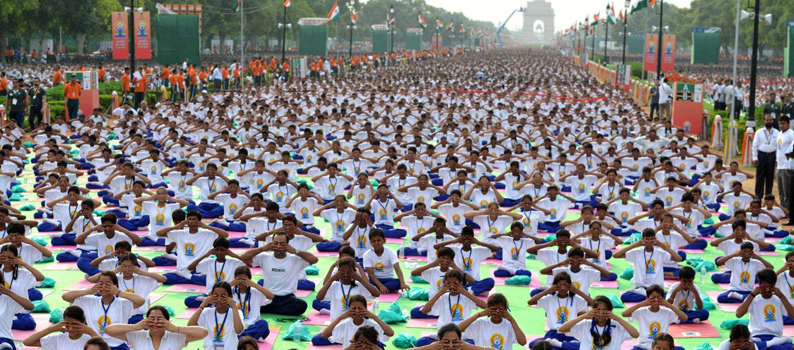India and Yoga

In an age where we are constantly competing with someone or something, we generally fail to see the ultimate bigger picture. We fail to ask ourselves what are we striving for and what is the goal of our life. Yoga would definitely not provide you with the answer, but yes, it would indeed provide you with a means to the end or rather a road map through which you can find out the answer yourself.
Yoga in Sanskrit originally means “to join”. In simple words yoga aims to join the body and mind with the soul. If you look at it from a spiritual point of view then it can be said that yogis follow a step by step process to dissolve the ego consciousness with the soul consciousness, through which they can realize the Paramatma (God). In its truest essence Yoga aims to reverse the process of creation and our bondage to the cycle of birth and death.
Ancient History of Yoga in India
Nobody is sure about the origin of Yoga. Earlier historians believed that yoga came into existence 500 years back, during the time of Gautam Buddha. This concept was refuted when excavations of the Indus valley civilization started and figurines resembling different yogic postures were found in soapstone seals. Rig Veda, which is popularly known as the first book of mankind mentions yogic meditation. Yajur Veda exhorts mankind to practice yoga for enhancing mental health, physical strength, and prosperity. In addition, yoga-related terms like pranayama and samadhi occur repeatedly in Bhagavad-Gita. Yoga was systemized by Patanjali in the Yoga Sutras during the time frame between 300–200 B.C. According to him, yoga was the only way for the soul to know its true self.
Popularity of Yoga during the 19th Century.
Yoga got its worldwide recognition when Swami Vivekananda spoke about the practice of Yoga in the World Parliament of Religions in Chicago in 1893. He lectured about this ancient form of holistic healing in different parts of America and Europe and founded the Vedanta Society for propagating this practice. During the early 20th century a number of teachers from India migrated to the Western countries to teach yoga. They authored numerous books, detailing the benefits yoga had on the human mind and body.
Types of Yoga’s
Hatha Yoga- It was introduced by Yogi Swatmarama, in the 15th century in India. Hath Yoga encompasses styles which includes Bikram Yoga, Ashtanga Yoga, and Kundalini Yoga and aims for the physical wellness of a person. This form of yoga aims to bring about a balance between the positive and negative energies of the body.
Kundalini Yoga- This form of yoga, focuses on different yoga postures, fast breathing practices and meditation techniques. This form of Yoga is more spiritual in nature and aims to activate the root chakra in the human body, through which an increased awareness of the surrounding environment can be created.
Raja Yoga- Raja Yoga aims to give a person control over his thoughts so that they can direct them towards a more positive domain. Raja Yoga is one of the six traditional schools of Hindu philosophy and aims to provide its practitioner with the power of detachment so that he can enjoy everything without getting attached or bound by them.
Karma Yoga- Karma yoga is a form of Yoga which teaches the karma yogi to practice selfless action without aspiring for any kind of material or spiritual gains. The dialogue between Arjun and Sri Krishna in Bhagwad Gita embodies the principal of Karma Yoga.
Bhakti Yoga- The origin of Bhakti Yoga can be traced back to the Upanishads, which is focused on the cultivation of love and devotion towards God. In Bhakti Yoga, the yogi aims to attain spiritual liberation through the attainment of oneness with God.
Over a period of time this ancient practice of yoga has undergone many changes, to become adaptable with the needs of the modern civilization. In the postmodern era, where everyday life has become too stressful and burdened with anxiety, practicing yoga can open the doors of inner peace and happiness.
- Karma Yoga
- Jnana Yoga
- Bhakti Yoga
- Kriya Yoga
- Asanas / Postures
- ARDHACAKRASANA
- BHUJANGASANA
- CHACKRASANA
- DHANURASANA
- View More
- Different forms of Yoga
- Hatha Yoga
- Kundalini Yoga
- Bhakti Yoga
- Karma Yoga
- View More
- Pranayama
- Suryabhedan
- Ujjayi
- Sheetali
- Sheetkari
- View More
- UN Declaration of Yoga Day
- Objectives of World Yoga Day
- Controversy on Yoga day
- Logo of Internation Yoga Day
- Fundamentals of Yoga
- Hand Mudra
- Yoga Day Messages
- Yoga Day SMS
- Yoga Day What's App Messages
- Yoga Day Essay
- Yoga Day Speech
- When is Yoga Day
- Yoga Day Quotes
- Yoga Day Poems
- Benefits of Yoga
- Slogans on Yoga
- Yoga Day Clipart
- Yoga Day Images
- Articles
- A Way Celebrating Your Health
- 10 Extraordinary benefits of Yoga
